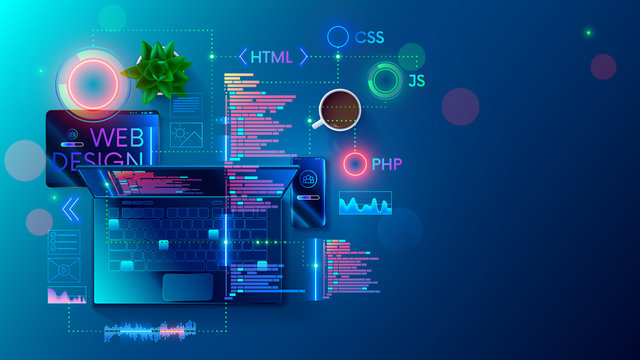The Very Best Kinds Of Web Style to Boost Individual Experience and Involvement
In the ever-evolving landscape of digital interaction, the effectiveness of Web design considerably affects individual experience and interaction. Different style strategies, such as minimal, receptive, and interactive formats, each deal special benefits that can cater to diverse individual requirements.
Minimalist Web Design
As electronic landscapes become significantly cluttered, minimal website design has actually become a powerful method to enhancing user experience. This design philosophy focuses on simpleness, concentrating on vital aspects while eliminating unnecessary distractions. By utilizing adequate white area, straightforward navigation, and a minimal shade palette, minimal style promotes clarity and routes individual attention to vital web content.
The core principle of minimal website design is to develop a seamless interaction for customers. By decreasing cognitive load, customers can quickly grasp details without feeling bewildered. This direct strategy not only enhances functionality but additionally motivates engagement, as site visitors are most likely to check out a site that is aesthetically attractive and very easy to browse.
Furthermore, minimal layout commonly emphasizes typography and images, utilizing these aspects strategically to communicate messages effectively. This concentrate on essential elements can boost brand identification and develop an unforgettable customer experience. Essentially, minimal website design is not just a fad; it is a thoughtful methodology that acknowledges the relevance of user-centered design. By removing away nonessential aspects, developers can create a much more interesting, reliable, and enjoyable Web experience for all customers.
Responsive Website Design
In today's diverse digital atmosphere, receptive Web layout has become vital for developing a smooth individual experience across a plethora of tools. As customers access websites on mobile phones, laptops, desktops, and tablets, the capacity of a site to adapt its layout and content to various display dimensions and resolutions is critical.
Receptive website design utilizes flexible grids, photos, and CSS media questions to make certain that Web content is provided optimally, no matter the device used. This method not only boosts the aesthetic appeal of a website yet likewise considerably improves use. Individuals are much more likely to involve with a website that offers a regular experience, as it gets rid of the irritation of having to focus or scroll excessively.
By taking on receptive design, services can improve their visibility and reach a broader target market. In recap, receptive Web style is an essential technique that enhances individual experience, interaction, and general complete satisfaction.
Interactive Website Design
Receptive website design lays the groundwork for boosting customer experience, however interactive website design takes this an action additionally by involving customers in a much more vibrant method - Aligned Position Web Design. By incorporating elements such as computer animations, clickable prototypes, and real-time responses, interactive Web style mesmerizes individuals, attracting them right into a richer surfing experience
This technique not just fosters interaction but additionally encourages individuals to discover material proactively instead of passively eating it. Techniques such as gamification, where users earn benefits for completing jobs, can significantly boost the moment invested in a site and improve overall contentment. In addition, interactive attributes can simplify complex information, making it a lot more digestible and enjoyable.

Integrating interactive design aspects can likewise result in greater conversion rates, as individuals are more probable to engage with a site that actively involves them. Aligned Position Web Design. Inevitably, interactive website design transforms customer experiences into memorable trips, making certain that visitors return time and again
Apartment Style
Defined by its minimalistic approach, level layout stresses simplicity and performance, stripping away unneeded aspects and concentrating on necessary features. This layout philosophy prioritizes functionality, guaranteeing that users can browse user interfaces browse around this site effortlessly and effectiveness. By employing a tidy visual, flat layout removes the mess usually discovered in much more elaborate styles, consequently boosting user concentrate on content and capability.
The characteristic of level layout exists in its usage of vibrant colors, easy typography, and geometric forms. These aspects contribute to a visually enticing interface that is both modern and approachable. In addition, level style cultivates a feeling of clearness, permitting individuals to determine necessary actions and info without disturbance.
Moreover, flat design is especially effective in responsive Web layout, as its simpleness equates well across various gadgets and display sizes. The lack of complex textures and slopes reduces filling times, which is important for keeping customer interaction. As digital landscapes remain to progress, flat layout remains a relevant choice for developing straightforward web sites that improve overall experience. By focusing on essential functions, level style not only fulfills customer requirements but likewise urges seamless communication, making it a vital element of efficient Web design strategies.
Flexible Web Design
Adaptive Web style personalizes the customer experience read this article by developing numerous fixed layouts tailored to different screen sizes and gadgets. Unlike responsive style, which fluidly changes a solitary format, adaptive design utilizes unique layouts for certain breakpoints, guaranteeing optimum presentation on different platforms. This technique enables designers to concentrate on the special attributes of each gadget, improving functionality by providing exactly what users need based upon their context.
Among the key benefits of adaptive Web style is its ability to optimize load times and efficiency. By offering tailored content and images that fit the customer's tool, web sites can lessen data use and boost loading rates. This is especially advantageous for users with slower links or restricted data strategies.

Furthermore, flexible design promotes a more consistent and controlled branding experience. Given that designers create several formats, they can guarantee that the visual components align with the brand's identity throughout various platforms - Aligned Position Web Design. This results in a cohesive individual experience, boosting engagement and promoting individual retention
Final Thought
Minimal style promotes clearness and focus, while receptive layout makes sure versatility across various devices, advertising access. Jointly, these design approaches add to the development of easy to use environments that not just enhance complete satisfaction but additionally drive greater conversion rates, underscoring their critical relevance in contemporary Web layout methods.

Minimalist design fosters clarity and focus, while responsive design guarantees versatility throughout different gadgets, advertising access. Jointly, these layout comes close to add to the production of straightforward settings that not just enhance contentment yet likewise drive higher conversion rates, underscoring their crucial significance in contemporary Web layout approaches.
 Jonathan Taylor Thomas Then & Now!
Jonathan Taylor Thomas Then & Now! Keshia Knight Pulliam Then & Now!
Keshia Knight Pulliam Then & Now! Danica McKellar Then & Now!
Danica McKellar Then & Now! Robbie Rist Then & Now!
Robbie Rist Then & Now! Megyn Kelly Then & Now!
Megyn Kelly Then & Now!